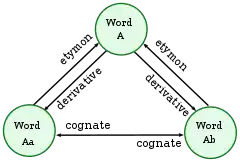Cognate
In historical linguistics, cognates or lexical cognates are sets of words that have been inherited in direct descent from an etymological ancestor in a common parent language.[1] Because language change can have radical effects on both the sound and the meaning of a word, cognates may not be obvious, and often it takes rigorous study of historical sources and the application of the comparative method to establish whether lexemes are cognate. Cognates are distinguished from loanwords, where a word has been borrowed from another language.

Characteristics
Cognates need not have the same meaning, which may have changed as the languages developed independently. For example English starve and Dutch sterven 'to die' or German sterben 'to die' all descend from the same Proto-Germanic verb, *sterbaną 'to die'.
Cognates also do not need to look or sound similar: English father, French père, and Armenian հայր (hayr) all descend directly from Proto-Indo-European *ph₂tḗr. An extreme case is Armenian երկու (erku) and English two, which descend from Proto-Indo-European *dwóh₁; the sound change *dw > erk in Armenian is regular.
An example of cognates from the same Indo-European root are: night (English), nicht (Scots), Nacht (German), nacht (Dutch, Frisian), nag (Afrikaans), Naach (Colognian), natt (Swedish, Norwegian), nat (Danish), nátt (Faroese), nótt (Icelandic), noc (Czech, Slovak, Polish), ночь, noch (Russian), ноќ, noć (Macedonian), нощ, nosht (Bulgarian), ніч, nich (Ukrainian), ноч, noch/noč (Belarusian), noč (Slovene), noć (Serbo-Croatian), nakts (Latvian), naktis (Lithuanian), nos (Welsh/Cymraeg), νύξ, nyx (Ancient Greek), νύχτα / nychta (Modern Greek), nakt- (Sanskrit), natë (Albanian), nox, gen. sg. noctis (Latin), nuit (French), noche (Spanish), nueche (Asturian), noite (Portuguese and Galician), notte (Italian), nit (Catalan), nuet/nit/nueit (Aragonese), nuèch / nuèit (Occitan) and noapte (Romanian). These all mean 'night' and derive from the Proto-Indo-European *nókʷts 'night'. The Indo-European languages have hundreds of such cognate sets, though few of them are as neat as this.
The Arabic سلام salām, the Hebrew שלום shalom, the Assyrian Neo-Aramaic shlama and the Amharic selam 'peace' are cognates, derived from the Proto-Semitic *šalām- 'peace'.
False cognates
False cognates are pairs of words that appear to have a common origin, but which in fact do not. For example, Latin habēre and German haben both mean 'to have' and are phonetically similar. However, the words evolved from different Proto-Indo-European (PIE) roots: haben, like English have, comes from PIE *kh₂pyé- 'to grasp', and has the Latin cognate capere 'to seize, grasp, capture'. Habēre, on the other hand, is from PIE *gʰabʰ 'to give, to receive', and hence cognate with English give and German geben.[3]
Likewise, English much and Spanish mucho look similar and have a similar meaning, but are not cognates: much is from Proto-Germanic *mikilaz < PIE *meǵ- and mucho is from Latin multum < PIE *mel-. A true cognate of much is the archaic Spanish maño 'big'.[4]
Distinctions
Cognates are distinguished from other kinds of relationships.
- Loanwords are words borrowed from one language into another, for example English beef is borrowed from Old French boef (meaning "ox"). Although they are part of a single etymological stemma, they are not cognates.
- Doublets are pairs of words in the same language which are derived from a single etymon, which may have similar but distinct meanings and uses. Often one is a loanword and the other is the native form, or they have developed in different dialects and then found themselves together in a modern standard language. For example, Old French boef is cognate with English cow, so English cow and beef are doublets.
- Translations, or semantic equivalents, are words in two different languages that have similar or practically identical meanings. They may be cognate, but usually they are not. For example, the German equivalent of the English word cow is Kuh, which is also cognate, but the French equivalent is vache, which is unrelated.
Related terms
Etymon (ancestor word) and descendant words
An etymon, or ancestor word, is the ultimate source word from which one or more cognates derive. In other words, it is the source of related words in different languages. For example, the etymon of both Welsh ceffyl and Irish capall is the Proto-Celtic *kaballos (all meaning horse).
Descendants are words inherited across a language barrier, coming from a particular etymon in an ancestor language. For example, Russian мо́ре and Polish morze are both descendants of Proto-Slavic *moře (meaning sea).
Root and derivatives
A root is the source of related words within a single language. Similar to the distinction between etymon and root, a nuanced distinction can sometimes be made between a descendant and a derivative.
A derivative is one of the words which have their source in a root word, and were at some time created from the root word using morphological constructs such as suffixes, prefixes, and slight changes to the vowels or to the consonants of the root word. For example unhappy, happily, and unhappily are all derivatives of the root word happy.
The terms root and derivative are used in the analysis of morphological derivation within a language, in studies that are not concerned with historical linguistics, and that do not cross the language barrier.
References
- Crystal, David, ed. (2011). "cognate". A Dictionary of Linguistics and Phonetics (6th ed.). Blackwell Publishing. pp. 104, 418. ISBN 978-1-4443-5675-5. OCLC 899159900.
- "cognate", The American Heritage Dictionary of the English Language, 4th ed.: "Latin cognātus: co-, co- + gnātus, born, past participle of nāscī, to be born." Other definitions of the English word include "[r]elated by blood; having a common ancestor" and "[r]elated or analogous in nature, character, or function".
- Lexikon der indogermanischen Verben
- Ringe, Don. "A quick introduction to language change" (PDF). Univ. of Pennsylvania: Linguistics 001 (Fall 2011). ¶ 29. pp. 11–12. Archived from the original (PDF) on 20 June 2010. Retrieved 15 June 2014.
{{cite web}}: CS1 maint: location (link)